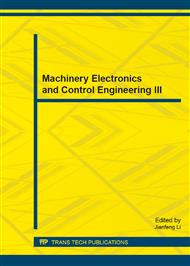p.776
p.783
p.788
p.792
p.796
p.801
p.805
p.809
p.813
Odor Source Localization Research of Mobile Robots in Indoor Environments
Abstract:
Aiming at the odor source localization in an obstacle-filled wind-varying indoor environment, a new method based odor source localization algorithm for a single mobile robot is proposed. With the information of the wind and the concentration gradient, Wasps can find odor source in a short time. However, it is very difficult for mobile robots to mimic the behaviors of wasps exactly. So, besides the bionics, BP neural network is adopted for the mobile robot to find the odor source. The control strategies for the plume-tracing mobile robot are proposed which include the intelligent plume-tracing algorithm and the collision avoidance algorithm based on improved potential grid method. The algorithms were integrated to control the robot trace plumes in obstructed indoor environments. Experimental results have demonstrated the capability of this kind of plume-tracing mobile robot.
Info:
Periodical:
Pages:
796-800
Citation:
Online since:
December 2013
Authors:
Price:
Сopyright:
© 2014 Trans Tech Publications Ltd. All Rights Reserved
Share:
Citation:


